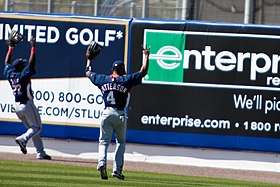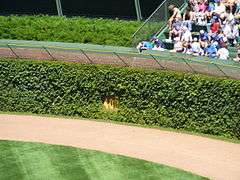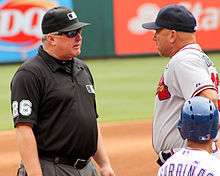Ground rule double
A ground rule double is a baseball rule that awards two bases from the time of pitch to all baserunners including the batter-runner, as a result of the ball leaving play after being hit fairly and leaving the field under a condition of the ground rules in effect at the field where the game is being played. An automatic double is the term used to refer to a fairly hit ball leaving the field in circumstances that do not merit a home run. The automatic double (or rule-book double) is quite often mistakenly called a ground rule double.[1]

Application
Major League Baseball (MLB) has a set of universal ground rules that apply at all ballparks, two of which award two bases to the batter and any baserunners:[2]
- A batted ball lodged in the roof above fair territory (unless outlined otherwise in the home park ground rules)
- Any batted ball in fair territory that, in flight, strikes the facing of a lower wall and then bounds over a higher wall

Two bases can also be awarded per home park ground rules—rules created to provide for unique playing conditions of a specific ballpark. For example, ground rules govern the situation when a batted ball is lodged in the ivy at Wrigley Field,[3] or the walkways near the ceiling of Tropicana Field, a domed stadium.[4]
The far more commonly occurring automatic double results from the generally applicable MLB rules 5.05(a)(6) through 5.05(a)(9).[5]:22–23 These rules govern how to treat the batter (and any runners on base) when a batted ball is hit fair but passes out of the field of play or becomes artificially obstructed while in the field of play. For example, these rules cover balls that hit the ground in fair territory and land out of play, typically by bouncing over a fence or wall in the outfield. The rules also provide generically for the award of a double when a batted ball goes through or under a fence; and when it goes through or sticks in shrubbery or vines on the fence.

One of the MLB rules, 5.05(a)(9),[5]:23 governs when fair fly balls are deflected into the stands by a fielder: for example, a fair fly ball deflected out of play by a fielder from a point less than 250 feet (76 m) from home plate is considered a double (beyond that distance, it is considered a home run). This applied in an unusual play August 3, 2007, when Melky Cabrera of the New York Yankees hit a ball that ricocheted off Kansas City Royals pitcher Ryan Braun's foot and bounced into the stands in foul territory.[6]
When two bases are awarded by either ground rules or the automatic rule, any baserunners ahead of the batter are entitled to advance two bases from their positions at the time of pitch. Only in the case of interference is the umpire vested with discretion to award more bases (see MLB rule 6.01).[5]:63–69 Application of the ground rule or automatic double rule can result in a runner at first base, who appears to have been able to score on a batted ball, being required to returned to third base due to the ball going out of play.[7][8]
History
In the early years of baseball, batted balls that cleared the fence in fair territory on the fly or after a bounce were counted as home runs. The rule was changed by the American League prior to the 1929 season and by the National League prior to the 1931 season.[9][10] Baseball records did not differentiate between home runs that cleared the fence on the fly and those that bounced over. Notably, this includes most of Babe Ruth's career, including when he hit 60 home runs in 1927.[11] The last "bounce" home run in MLB was hit by Al López of the Brooklyn Robins on September 12, 1930, at Ebbets Field.[9]
References
- Dickson, Paul (2011). The Dickson Baseball Dictionary (Third ed.). p. 390. ISBN 978-0-393-07349-2.
- "Universal Ground Rules". MLB.com. Retrieved April 15, 2020.
- Sullivan, Paul (October 21, 2015). "Wrigley Field Ivy Has an Appetite for Baseballs". Chicago Tribune. Retrieved February 27, 2017.
- "J.D. Martinez Robbed of Home Run by Tropicana Field Catwalk". 2015. Retrieved April 15, 2020 – via YouTube.
- "Official Baseball Rules" (PDF). Office of the Commissioner of Baseball. 2019. Retrieved April 15, 2020 – via mlbstatic.com.
- Hoch, Bryan (2007-08-04). "Wang wins 13th as A-Rod stays put". Archived from the original on 2018.
- Snyder, Matt (October 21, 2015). "Umpires should have discretion on ground-rule doubles". CBS Sports. Retrieved April 15, 2020.
- "New York Mets at Chicago Cubs NLCS Game 3 Highlights October 20, 2015". Retrieved April 15, 2020 – via YouTube.
- O'Gara, Connor. "Future Hall of Famer Al López Hits the Last 'Bounce' Home Run in Big League History". baseballhall.org. Retrieved April 16, 2020.
- "Changes are Made in the Baseball Playing Rules by Joint Rules Committee". Santa Cruz Evening News. Santa Cruz, California. December 17, 1930. p. 8. Retrieved April 16, 2020 – via newspapers.com.
- "Babe's Bounces". The New York Times. July 19, 1998. p. 8.11. Retrieved April 16, 2020 – via nytimes.com.
Further reading
- Neyer, Rob (May 3, 2004). "Ballpark quirks at their best". ESPN.com. Retrieved April 15, 2020.